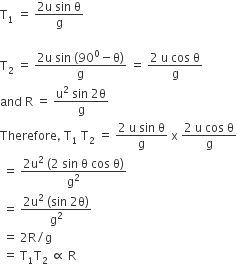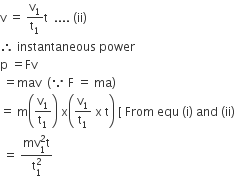A projectile can have the same range R for two angles of projection. If T1 and T2 be the time of flights in the two cases, then the product of the two time of flights is directly proportional to
1/R2
1/R
R
R
C.
R
We know in advance that range of projectile is same for complementary angles i.e. for θ and (900 - θ )
A body of mass m accelerates uniformly from rest to v1 in time t1. The instantaneous power delivered to the body as a function of time t is




B.

Let the constant acceleration of body of mass m is a.
From equation of motion
v1 = 0 + at1
⇒ a = t2/t1 = ...... (i)
At an instant t, the velocity v of the body v = 0 + at
Which of the following statements is false for a particle moving in a circle with a constant angular speed?
The velocity vector is tangent to the circle.
The acceleration vector is tangent to the circle.
The acceleration vector points to the centre of the circle.
The acceleration vector points to the centre of the circle.
B.
The acceleration vector is tangent to the circle.
A particle is acted upon by a force of constant magnitude which is always perpendicular to the velocity of the particle, the motion of the particle takes place in a plane. It follows that
its velocity is constant
its acceleration is constant
its kinetic energy is constant
its kinetic energy is constant
C.
its kinetic energy is constant
When a force of constant magnitude acts on the velocity of particle perpendicularly, then there is no change in the kinetic energy of the particle. Hence, kinetic energy remains constant.
